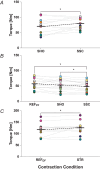The stretch-shortening cycle effect is not associated with cortical or spinal excitability modulations
- PMID: 40532095
- PMCID: PMC12320215
- DOI: 10.1113/JP287508
The stretch-shortening cycle effect is not associated with cortical or spinal excitability modulations
Abstract
It is unclear whether cortical and spinal excitability modulations contribute to enhanced stretch-shortening cycle (SSC) performance. Therefore, this study investigated cortical and spinal excitability modulations during and following shortening of SSC contractions compared with pure shortening (SHO) contractions. Participants (n = 18) performed submaximal voluntary plantar flexion contractions while prone on the dynamometer bench. The right foot was strapped onto the dynamometer's footplate attachment, and the resultant ankle joint torque and crank arm angle were recorded. Cortical and spinal excitability modulations of the soleus muscle were analysed by eliciting compound muscle actional potentials via electrical nerve stimulation, cervicomedullary motor-evoked potentials (CMEPs) via electrical stimulation of the spinal cord, and motor-evoked potentials (MEPs) via magnetic stimulation of the motor cortex. Mean torque following stretch was significantly increased by 7 ± 3% (P = 0.029) compared with the fixed-end reference (REF) contraction, and mean torque during shortening of SSC compared with SHO was significantly increased by 12 ± 24% (P = 0.046). Mean steady-state torque was significantly lower by 13 ± 3% (P = 0.006) and 9 ± 12% (P = 0.011) following SSC compared with REF and SHO, respectively. Mean steady-state torque was not significantly different following SHO compared with REF (7 ± 8%, P = 0.456). CMEPs and MEPs were also not significantly different during shortening of SSC compared with SHO (P ≥ 0.885) or during the steady state of SSC, SHO and REF (P ≥ 0.727). Therefore, our results indicate that SSC performance was not associated with cortical or spinal excitability modulations during or after shortening, but rather driven by mechanical mechanisms triggered during active stretch. KEY POINTS: A stretch-shortening cycle (SSC) effect of 12% was observed during EMG-matched submaximal voluntary contractions of the human plantar flexors. The SSC effect was neither associated with cortical or spinal excitability modulations nor with stretch-reflex activity. The SSC effect was likely driven by mechanical mechanisms related to active muscle stretch, which have long-lasting effects during shortening. Residual force depression following SSC was not attenuated by the long-lasting mechanical mechanisms triggered during active muscle stretch. Steady-state torques were lower following shortening of SSCs versus pure shortening and fixed-end contractions at the same final ankle joint angle, but the torque differences were not correlated with cortical or spinal excitability modulations.
Keywords: force depression; force enhancement; performance enhancement; stretch reflex; triceps surae.
© 2025 The Author(s). The Journal of Physiology published by John Wiley & Sons Ltd on behalf of The Physiological Society.
Conflict of interest statement
The authors declare they have no competing interests.
Figures






References
-
- Brownstein, C. G. , Ansdell, P. , Škarabot, J. , Howatson, G. , Goodall, S. , & Thomas, K. (2018). An optimal protocol for measurement of corticospinal excitability, short intracortical inhibition and intracortical facilitation in the rectus femoris. Journal of the Neurological Sciences, 394, 45–56. - PubMed
-
- Cavagna, G. A. , Dusman, B. , & Margaria, R. (1968). Positive work done by a previously stretched muscle. Journal of Applied Physiology, 24(1), 21–32. - PubMed
MeSH terms
Grants and funding
LinkOut - more resources
Full Text Sources
